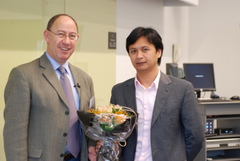
A Filipino scientist has received the highest prize from the Danish Optical Society (DOPS) for his current work with lasers and laser sensors.
Peter John Rodrigo, a researcher for the Technical University of Denmark (DTU) Fotonik Optical Sensor Technology group who has been living in the country for the past ten years, received the prestigious 2012 DOPS Prize for his work on wind LiDAR (Light Detection And Ranging) and optical trapping. The Danish Optical Society is considered as the “most important professional organization devoted to Denmark’s activities on scientific and technical aspects of optics.”
According to DOPS website, the prize is given “to young researchers, development engineer or other person who has made an extraordinary effort in the optical field.”
DOPS awarded Rodrigo a diploma and cash prize during their annual meeting, and the Northern Optics conference on Nov. 19-20 in Snekkersten, Denmark.
His papers on optical trapping made it in three consecutive December issues of the Optical Society of America’s Optics and Photonics News as “one of the most exciting optics research for 2003, 2004 and 2005.”
Rodrigo’s wind lidar can remotely measure wind direction and velocity accurately. DTU Fotonik is now commercializing the technology developed from his study through a start-up company, Windar Photonics A/S.
At the DTU Fotonic website, the wind lidar project aims to “develop, demonstrate and validate prototype laser wind sensors that measure wind speed and direction based on low-cost, compact semiconductor lasers and new optical methods we have recently devised and patented.”
“These wind sensor prototypes will represent the next-generation of compact, rugged and inexpensive laser-based wind sensors for wind energy research and turbine industry,” says the abstract.
He took up his Bachelor’s and Master’s degree at the National Institute of Physics, University of the Philippines Diliman, and his doctorate degree from the prestigious Niels Bohr Institute of the University of Copenhagen.
Rodrigo was unavailable for comment as of press time. However, in a post on the Imprints of Philippine Science Blog, Rodrigo cited his idol, Dennis Gabor, scientist and inventor of the Holographic technique, as a key inspiration for his work.
“The future cannot be predicted, but futures can be invented,” Rodrigo was quoted as saying.
The owner of the blog, Nathaniel Hermosa, also a Filipino scientist, was the first to alert GMA News Online of Rodrigo’s victory and says that he was able to get in touch with the latter shortly thereafter.
“I asked him personally. We are friends from way back,” he told GMA News Online in an email.
